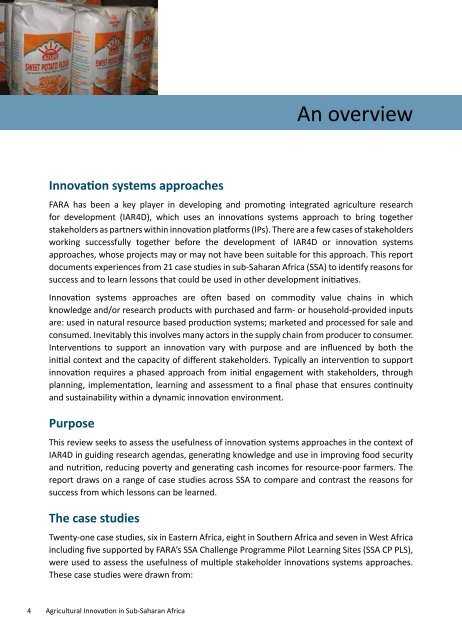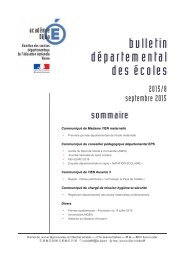agrl_innovations_in_ssa.pdf?utm_content=buffercb41d&utm_medium=social&utm_source=twitter
agrl_innovations_in_ssa.pdf?utm_content=buffercb41d&utm_medium=social&utm_source=twitter
agrl_innovations_in_ssa.pdf?utm_content=buffercb41d&utm_medium=social&utm_source=twitter
Create successful ePaper yourself
Turn your PDF publications into a flip-book with our unique Google optimized e-Paper software.
An overview<br />
Innovation systems approaches<br />
FARA has been a key player <strong>in</strong> develop<strong>in</strong>g and promot<strong>in</strong>g <strong>in</strong>tegrated agriculture research<br />
for development (IAR4D), which uses an <strong><strong>in</strong>novations</strong> systems approach to br<strong>in</strong>g together<br />
stakeholders as partners with<strong>in</strong> <strong>in</strong>novation platforms (IPs). There are a few cases of stakeholders<br />
work<strong>in</strong>g successfully together before the development of IAR4D or <strong>in</strong>novation systems<br />
approaches, whose projects may or may not have been suitable for this approach. This report<br />
documents experiences from 21 case studies <strong>in</strong> sub-Saharan Africa (SSA) to identify reasons for<br />
success and to learn lessons that could be used <strong>in</strong> other development <strong>in</strong>itiatives.<br />
Innovation systems approaches are often based on commodity value cha<strong>in</strong>s <strong>in</strong> which<br />
knowledge and/or research products with purchased and farm- or household-provided <strong>in</strong>puts<br />
are: used <strong>in</strong> natural resource based production systems; marketed and processed for sale and<br />
consumed. Inevitably this <strong>in</strong>volves many actors <strong>in</strong> the supply cha<strong>in</strong> from producer to consumer.<br />
Interventions to support an <strong>in</strong>novation vary with purpose and are <strong>in</strong>fluenced by both the<br />
<strong>in</strong>itial context and the capacity of different stakeholders. Typically an <strong>in</strong>tervention to support<br />
<strong>in</strong>novation requires a phased approach from <strong>in</strong>itial engagement with stakeholders, through<br />
plann<strong>in</strong>g, implementation, learn<strong>in</strong>g and assessment to a f<strong>in</strong>al phase that ensures cont<strong>in</strong>uity<br />
and susta<strong>in</strong>ability with<strong>in</strong> a dynamic <strong>in</strong>novation environment.<br />
Purpose<br />
This review seeks to assess the usefulness of <strong>in</strong>novation systems approaches <strong>in</strong> the context of<br />
IAR4D <strong>in</strong> guid<strong>in</strong>g research agendas, generat<strong>in</strong>g knowledge and use <strong>in</strong> improv<strong>in</strong>g food security<br />
and nutrition, reduc<strong>in</strong>g poverty and generat<strong>in</strong>g cash <strong>in</strong>comes for resource-poor farmers. The<br />
report draws on a range of case studies across SSA to compare and contrast the reasons for<br />
success from which lessons can be learned.<br />
The case studies<br />
Twenty-one case studies, six <strong>in</strong> Eastern Africa, eight <strong>in</strong> Southern Africa and seven <strong>in</strong> West Africa<br />
<strong>in</strong>clud<strong>in</strong>g five supported by FARA’s SSA Challenge Programme Pilot Learn<strong>in</strong>g Sites (SSA CP PLS),<br />
were used to assess the usefulness of multiple stakeholder <strong><strong>in</strong>novations</strong> systems approaches.<br />
These case studies were drawn from:<br />
4 Agricultural Innovation <strong>in</strong> Sub-Saharan Africa






